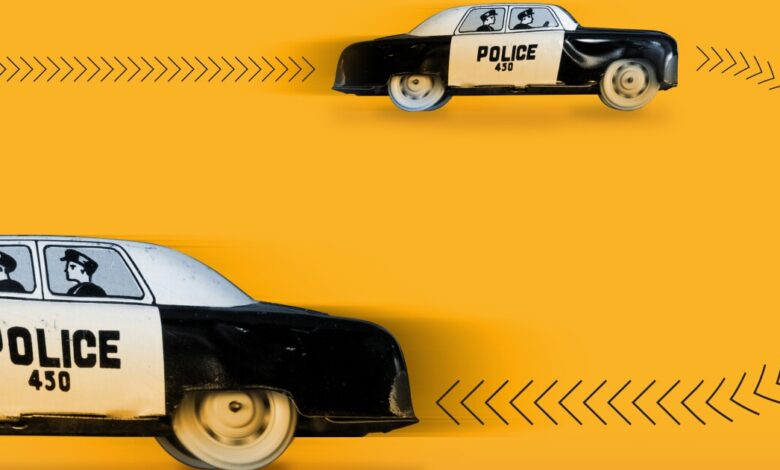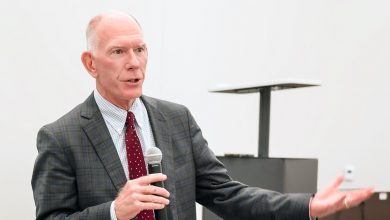Colleges Acted on Demands to Rein In Their Police. Then They Backtracked.

George Washington University’s police department will begin arming some officers this fall for the first time. Portland State University quietly moved away from a 2021 policy change that had restricted its officers’ ability to patrol with weapons.
The backlash was swift. George Washington students marched to the interim president’s on-campus residence; more than 200 faculty members signed a letter chastising the university’s board for failing to gather enough community input. Portland State students and faculty said the move felt like an invalidation of what activists had fought for and, in 2021, got closer to achieving: a campus without armed law enforcement.
Three years ago this week, the murder of George Floyd by a Minneapolis police officer galvanized a national conversation about law enforcement and systemic racism. Students and others on campuses became increasingly adamant that higher education needed to rethink its approach to policing. Many college leaders were receptive: They acknowledged that a significant police presence could make people of color feel unsafe and agreed to make certain changes.
But even though some college leaders gestured toward broader plans to reform their police departments, sweeping changes haven’t occurred — and in fact, George Washington and Portland State have moved in the opposite direction.
The leaders of these two universities have focused their rhetoric on concerns over increased crime and gun violence. To the activists who have, for years, pushed their institutions to imagine campuses without police, those arguments are misguided.
These developments highlight a persistent tension in the policing debate: College administrators aren’t going to eliminate law enforcement. Activists aren’t going to give up the fight to abolish the campus police. What does that mean for future conversations about campus safety?
From the jump, campus officials resisted the most far-reaching of activists’ demands. At the University of Louisville, the Black Student Union demanded the institution cut all ties with the Louisville Metro Police Department, whose officers had shot and killed Breonna Taylor, a 26-year-old Black woman, in March 2020. Neeli Bendapudi, the president at the time, explained to the Black Student Union’s president that the university could not agree to sever ties, because of overlapping jurisdictions and a reliance on the Louisville police for support.
Still, institutions quickly made smaller changes to demonstrate a commitment to racial justice and progressive policing. They restricted the kinds of force police officers could use and distanced themselves from municipal departments that were accused of brutality.
The Johns Hopkins University, for example, paused its plans to create an armed police force. The University of Minnesota-Twin Cities severed some of its ties with the Minneapolis Police Department. And the University of Michigan, like many institutions, assembled a task force to reconceptualize campus safety.
A lot can change in three years.
Hopkins is preparing to roll out its police department in the fall. Minnesota has rekindled its relationship with the Minneapolis police. And the Michigan task force disbanded with little to show for its work.
Charles H.F. Davis III, an assistant professor in the Center for the Study of Higher and Postsecondary Education at the University of Michigan, said the backpedaling on reform efforts “communicates a lack of political commitment” to the racial-justice priorities colleges identified in 2020. Davis served on the aforementioned Michigan task force.
Universities decided to wait it out until activism died out.
To be sure, many of the changes colleges made to their police departments in 2020 are still in effect, such as a ban at all California State University campuses on the carotid hold, which restricts the flow of blood to the brain. Colleges emphasize their continued commitment to racial justice in campus communications.
George Washington rolled out a new training program for officers, including lessons on de-escalation and identifying unconscious bias. The department added body-worn cameras and increased student participation in the officer-hiring process.
But colleges today can increase policing with less fanfare than they might have faced in 2020, Davis said. Most of the undergraduates who led protests against the police in 2020 have since graduated, taking with them that institutional memory.
“Universities decided to wait it out until activism died out,” Davis said.
Even if some of campus policing’s largest critics are gone, though, there are plenty of students, and faculty and staff members who have taken on the issue of armed officers.
“My goal right now is to make sure that Portland State University is able to hear the student voice,” said Hannah Alzgal, a senior and organizer with Disarm PSU, an activist group. “It’s unmistakable that this is not a decision that students have been vying for, and that we’re not being included in it.”
Kristen Roman, police chief at the University of Wisconsin at Madison and the director at large of the International Association of Campus Law Enforcement Administrators, said activism on her campus has been more prominent in the last three years she has been on the job than in her first three years.
“That’s one of the wonderful things about higher-education communities is that mobilization and activism is not uncommon for these communities — it’s encouraged,” Roman said. “It’s in terms of the relationship between police and communities, and some of those trust issues we’ve seen with greater visibility over the last three years — that has certainly prompted an increase in activism on our campuses.”
They’re concerned about crime near campus, for one. But also, they don’t want to be the next Virginia Tech, the next Umpqua Community College, the next Michigan State — institutions whose academic reputations are entangled with their legacies as the sites of massacres. If a shooter does come to campus, they want to be prepared.
At George Washington, “specially trained” officers will be given 9-millimeter handguns with which they can respond to emergencies, The GW Hatchet reported. Currently, the police department defers to other police agencies — and there are a number flanking the downtown Washington campus — when an emergency requires an armed response.
“Immediacy of response to life-threatening incidents is critical, but whenever weapons are involved, unarmed officers cannot respond and must rely instead on other armed law enforcement,” Mark Wrighton, interim president of George Washington University, explained in an email to the campus community.
Meanwhile, Portland State made the decision to increase armed patrols because officers were seeing more weapons on campus. In 2020, Portland State police officers seized three weapons on campus, said Willie Halliburton, the director of public safety. In 2021, they seized six. Last year, officers seized 13.
“I’m not talking just knives — I’m talking guns, semiautomatic pistols, long guns, rifles,” Halliburton told The Chronicle. “These are serious weapons that we were beginning to encounter pretty commonly. We are trying to do our job in a respectful manner and respect people’s liberties out there. But also we have to respect our officers, and their livelihood, and our campus.”
Portland State first created an armed police department in 2014. Campus activists protested the decision. Then the 2018 police killing of a 45-year-old Black man, Jason Washington, at a bar off campus further galvanized them. Washington, a Navy veteran, was armed as he tried to break up a fight.
The university’s move to disarm police patrols in 2021 appeared at first to be a step toward curtailing campus law enforcement. Yet the university never fully disarmed its patrols. Officers just had to receive permission from senior campus-safety leaders in order to carry weapons.
While the primary purpose of arming more patrols is to protect officers who encounter weapons, Halliburton said the number of mass shootings also factored into the decision.
“One way to be prepared is to have our officers have the appropriate tools to respond in an expedient manner to a situation like that,” Halliburton, of Portland State, said. “We just keep our fingers crossed that it doesn’t happen, but we wouldn’t want to be unprepared if it does happen.”
There have been 237 mass shootings in the U.S. so far in 2023, according to the Gun Violence Archive, which defines a mass shooting as four or more people shot or killed, excluding the shooter. There were 647 mass shootings in all of 2022.
It is unclear how many of those occurred on college campuses, but experts say such tragedies remain relatively rare. As for whether crime is on the rise in general, a complicated picture emerges.
In Washington, D.C., violent crime — which the Federal Bureau of Investigation considers to include forcible rape, aggravated assault, robbery, and murder or nonnegligent manslaughter — is up 15 percent over the same time period last year. Property crime is up 31 percent.
In Portland, Ore., violent crime was down 5.8 percent in the first four months of the year compared with the same time period in 2022. Property crime was down 9.7 percent.
Data collected under the federal Clery Act does not reveal significant patterns in on-campus crime at either George Washington or Portland State Universities. The numbers for both violent and property offenses have fluctuated since 2014, the first year for which the current methodology was used.
William Pelfrey Jr., a professor in Virginia Commonwealth University’s L. Douglas Wilder School of Government and Public Affairs who studies policing and public safety, said it is unusual for institutions of George Washington University’s size — 26,457 students and 6,030 staff members — not to have armed police departments. Portland State, which employs nine armed police officers, has 22,858 students and 3,047 staff members.
“It would be very difficult for a large college or university to claim that they have an orientation toward the safety of their faculty, staff, and students without an armed police department,” Pelfrey said. “If you have 40,000, 50,000, 60,000 people on your campus — there’s very few cities of that size that don’t have an armed police department.”
Relying on local police to respond when incidents require armed officers can delay response times, Pelfrey said.
“We determined it is critical to equip our highly trained police supervisors who know our campuses best with the ability to quickly respond to such emergencies in situations where seconds matter most,” Joshua Grossman, a spokesperson for George Washington, said in a statement.
Relatedly, many municipal police departments are understaffed, including the Portland Police Bureau and Washington’s Metropolitan Police Department, and therefore can’t respond to all the calls they get.
“That’s what led us back to armed patrols,” Halliburton said. “We can’t depend on Portland to take those calls which were previously agreed upon.”
“That argument is short-sighted,” said Emily Ford, the president of Portland State’s chapter of the American Association of University Professors. “There is a plethora of evidence that when cops carry weapons, it doesn’t do anything to stop crime or violence.”
Ford, a librarian, cited the AAUP’s 2021 report on campus police forces, which asserted that there is “little evidence to justify such a large outlay of the campus budget.” Research on shootings in K-12 schools has found that armed police officers are not effective at preventing school shootings.
Instead, Ford and others argue, armed officers make campuses less safe, especially for members of marginalized groups.
Research has shown that people of color are disproportionately stopped by police, on and off campuses. A 2021 report by the University of Southern California found that 31.7 percent of stops by USC police officers in the 2019-2020 academic year involved Black people, who made up only 5.5 percent of the student body and 8.8 percent of its staff. Latino people were also disproportionately stopped by police.
Brendan Hornbostel, a Ph.D. student at George Washington who studies the histories of U.S. policing, characterized the university’s decision to arm some officers as extending a “velvet glove” to tuition-paying students and an “iron fist” to the homeless population around the urban campus.
Like the activists at Portland State, Hornbostel is skeptical of the mass-shootings argument.
“It’s a hell of a gotcha tactic on their part,” Hornbostel said. “Who is going to argue with, ‘What are you going to do with a mass shooting?’ Maybe the better question is, for all of the days that there is not a mass shooting on campus, there will be armed cops. That to me is just as terrifying.”
Stephen Percy, president of the university, knows that many people on his campus are frustrated. “As often as I heard, ‘We didn’t like the decision,’ I more often heard, ‘We didn’t know it was coming. It’s kind of a surprise. Why didn’t we know that?’”
He added: “I had to make the decision as president, given the safety of our officers and the situation we face, that on this limited period, to move forward.” Percy is retiring in July.
He said he assembled an ad-hoc committee to come up with a communication plan for public safety. He also changed the charge of the university’s public-safety oversight committee so that it is consulted not just on policy changes, but also changes in practice, such as the decision to increase armed patrols.
“If we do something like this again, we’ll actually consult with [the oversight committee] prior to making the decision,” Percy said.
The goal, Percy said, is still to fully disarm patrols. But that’s just not feasible at the moment.
Activists say they will keep the pressure on.
“Our demands remain the same, but we’re not focused on the continued disappointments,” said Katie Cagle, a staff member at Portland State and organizer with Disarm PSU. “We’re instead focused on having conversations with people about, ‘What does safety mean for you?’”
Ford, the campus AAUP president, said that Portland State’s chapter is strongly supportive of de-escalation teams patrolling campus, instead of armed police officers. Cagle added that community members would like more de-escalation training to help them respond to people in crisis.
Activists have had a few wins, Cagle said. One was getting the campus police department to publish its policy manual online, for anyone to view.
Still, she said, “That feels like feeling grateful for crumbs.”
Source link






